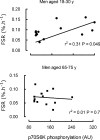Age-related differences in the dose-response relationship of muscle protein synthesis to resistance exercise in young and old men
- PMID: 19001042
- PMCID: PMC2670034
- DOI: 10.1113/jphysiol.2008.164483
Age-related differences in the dose-response relationship of muscle protein synthesis to resistance exercise in young and old men
Abstract
We investigated how myofibrillar protein synthesis (MPS) and muscle anabolic signalling were affected by resistance exercise at 20-90% of 1 repetition maximum (1 RM) in two groups (25 each) of post-absorptive, healthy, young (24 +/- 6 years) and old (70 +/- 5 years) men with identical body mass indices (24 +/- 2 kg m(-2)). We hypothesized that, in response to exercise, anabolic signalling molecule phosphorylation and MPS would be modified in a dose-dependant fashion, but to a lesser extent in older men. Vastus lateralis muscle was sampled before, immediately after, and 1, 2 and 4 h post-exercise. MPS was measured by incorporation of [1,2-(13)C] leucine (gas chromatography-combustion-mass spectrometry using plasma [1,2-(13)C]alpha-ketoisocaparoate as surrogate precursor); the phosphorylation of p70 ribosomal S6 kinase (p70s6K) and eukaryotic initiation factor 4E binding protein 1 (4EBP1) was measured using Western analysis with anti-phosphoantibodies. In each group, there was a sigmoidal dose-response relationship between MPS at 1-2 h post-exercise and exercise intensity, which was blunted (P < 0.05) in the older men. At all intensities, MPS fell in both groups to near-basal values by 2-4 h post-exercise. The phosphorylation of p70s6K and 4EBP1 at 60-90% 1 RM was blunted in older men. At 1 h post-exercise at 60-90% 1 RM, p70s6K phosphorylation predicted the rate of MPS at 1-2 h post-exercise in the young but not in the old. The results suggest that in the post-absorptive state: (i) MPS is dose dependant on intensity rising to a plateau at 60-90% 1 RM; (ii) older men show anabolic resistance of signalling and MPS to resistance exercise.
Figures





Comment in
-
Exercise intensity matters for both young and old muscles.J Physiol. 2009 Feb 1;587(3):511-2. doi: 10.1113/jphysiol.2008.166744. Epub 2008 Dec 15. J Physiol. 2009. PMID: 19074964 Free PMC article. No abstract available.
-
The battle to keep or lose skeletal muscle with ageing.J Physiol. 2009 Jan 15;587(1):1-2. doi: 10.1113/jphysiol.2008.167049. J Physiol. 2009. PMID: 19119178 Free PMC article. No abstract available.
References
-
- Baar K, Esser K. Phosphorylation of p70 (S6k) correlates with increased skeletal muscle mass following resistance exercise. Am J Physiol Cell Physiol. 1999;276:C120–C127. - PubMed
-
- Baumgartner RN, Koehler KM, Gallagher D, Romero L, Heymsfield SB, Ross RR, Garry PJ, Lindeman RD. Epidemiology of sarcopenia among the elderly in New Mexico. Am J Epidemiol. 1998;147:755–763. - PubMed
-
- Biolo G, Maggi SP, Williams BD, Tipton KD, Wolfe RR. Increased rates of muscle protein turnover and amino acid transport after resistance exercise in humans. Am J Physiol Endocrinol Metab. 1995;268:E514–E520. - PubMed
-
- Bowtell JL, Park DM, Smith K, Cuthbertson DJR, Waddell T, Rennie MJ. Stimulation of human quadriceps protein synthesis after strenous exercise: no effects of varying intensity between 60 and 90% of one repetition maximum (1RM) J Physiol. 2003;547.P:P16.
-
- Chesley A, MacDougall JD, Tarnopolsky MA, Atkinson SA, Smith K. Changes in human muscle protein synthesis after resistance exercise. J Appl Physiol. 1992;73:1383–1388. - PubMed
Publication types
MeSH terms
Substances
Grants and funding
LinkOut - more resources
Full Text Sources
Other Literature Sources
Medical
Research Materials

